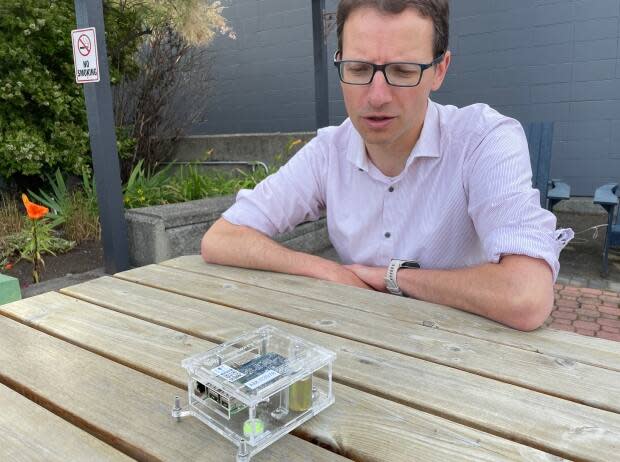Mini seismometers in schools aim to help students learn while gathering valuable earthquake data

More schools on Vancouver Island could soon be getting miniature seismometers that will help students learn about tectonics and also help communities better prepare for earthquakes.
SchoolShake is a new outreach and citizen science program in which researchers with the University of Victoria and Natural Resources Canada will use data from the machines placed in different schools to track small earthquakes and active faults.
The aim is to support science education while also helping communities prepare for large earthquakes like the anticipated "Big One" — a powerful quake that seismologists predict is likely to happen on the West Coast this century.
"By imaging or detecting lots and lots of small earthquakes, we can better understand those faults that will one day generate a big earthquake that could cause a lot of damage," Edwin Nissen, an associate professor of Earth and ocean sciences at the University of Victoria, said on the CBC's On the Island.
"There's lots and lots of little earthquakes, but we can only hear the little earthquakes if we have lots of these instruments out."
He said the miniaturized seismometer, called a Raspberry Shake, is a small clear box the size of a fist. It was created a few years ago through a Kickstarter campaign that was funded largely by professional seismologists and hobbyists.

"When there's a big earthquake or an earthquake that people can feel, teachers will be able to look at the seismographs with their students and discuss what an earthquake is and how you locate earthquakes," Nissen said.
Vancouver Island lies near the active boundary of the Pacific, Juan de Fuca and North American tectonic plates. According to Nissen, these plates have the potential to generate a large earthquake and volcanic activity.
"A young person growing up in Victoria now, there's a good chance they will feel a big damaging earthquake in their lifetime," he said.
Seismic upgrades 'key' focus
Nissen says data from the Raspberry Shake can also help the province make sound decisions on which schools to prioritize for seismic upgrades, based on their location.
Approximately 250 schools need upgrades for earthquake safety, according to the Ministry of Education's seismic school needs list. Some have been waiting years for an upgrade plan.
"We need to have those seismic upgrades done now," Clint Johnston, newly elected president of the B.C. Teachers' Federation (BCTF), told CBC News.
"There's not many places in British Columbia that aren't near a fault line, particularly as you get around the coast and on the Island. It's really important that the buildings become seismically upgraded. That's our key focus."
"Schools are one of those community based buildings that often serve actually as a refuge or a centre for activities," he added.
Education Minister Jennifer Whiteside said the NDP has spent $2.7 billion in the last four years opening new schools and doing seismic upgrades. She says the province is committed to spending $3 billion in the next three years to carry on that important work.
Every year, each of B.C.'s 60 school districts puts forward a five-year capital plan and the ministry decides which plans are a priority.
"The province has done a great job in retrofitting older schools ... but where should it focus its efforts and where should we retrofit first?" Nissen said.
He says the device will hopefully also spark an interest in Earth science for the students.
"Science at school is chemistry, physics, biology, math but I think Earth science is actually so central to so many of the big issues of today, like climate change, landslides, forest fires, sea level rise and earthquakes," he said.
Nissen says the Raspberry Shake is currently placed in four schools in Victoria and are aiming to install it at 10 schools by the end of the year.
He says if funding by the National Science and Engineering Research Council is approved, they'll be able to install the devices at around 50 schools on Vancouver Island.
"The more instruments we have, the smaller the earthquakes we can detect," he said.


